HRMM058 MBA Leadership Report: Employee Involvement Strategy
VerifiedAdded on 2023/06/13
|22
|5004
|104
Report
AI Summary
This report explores employee involvement strategies within a global context, specifically focusing on subsidiaries in China, India, and Germany. It analyzes the opportunities and challenges associated with cross-cultural management, employee motivation, teamwork, and performance management. The report leverages theoretical frameworks such as Maslow's Hierarchy of Needs, the IES Engagement Model, and the JD-R model to provide a comprehensive understanding of employee engagement drivers. It further examines cultural dimensions using Bennett’s scale, Trompenaars model and Hofstede’s cultural dimensions, and provides recommendations for fostering a highly engaged and productive workforce across diverse locations. The analysis covers motivation, engagement, teamwork, and performance, highlighting the importance of cultural sensitivity and tailored strategies. The report concludes with actionable recommendations to enhance employee involvement and overall organizational performance and similar resources are available on Desklib.
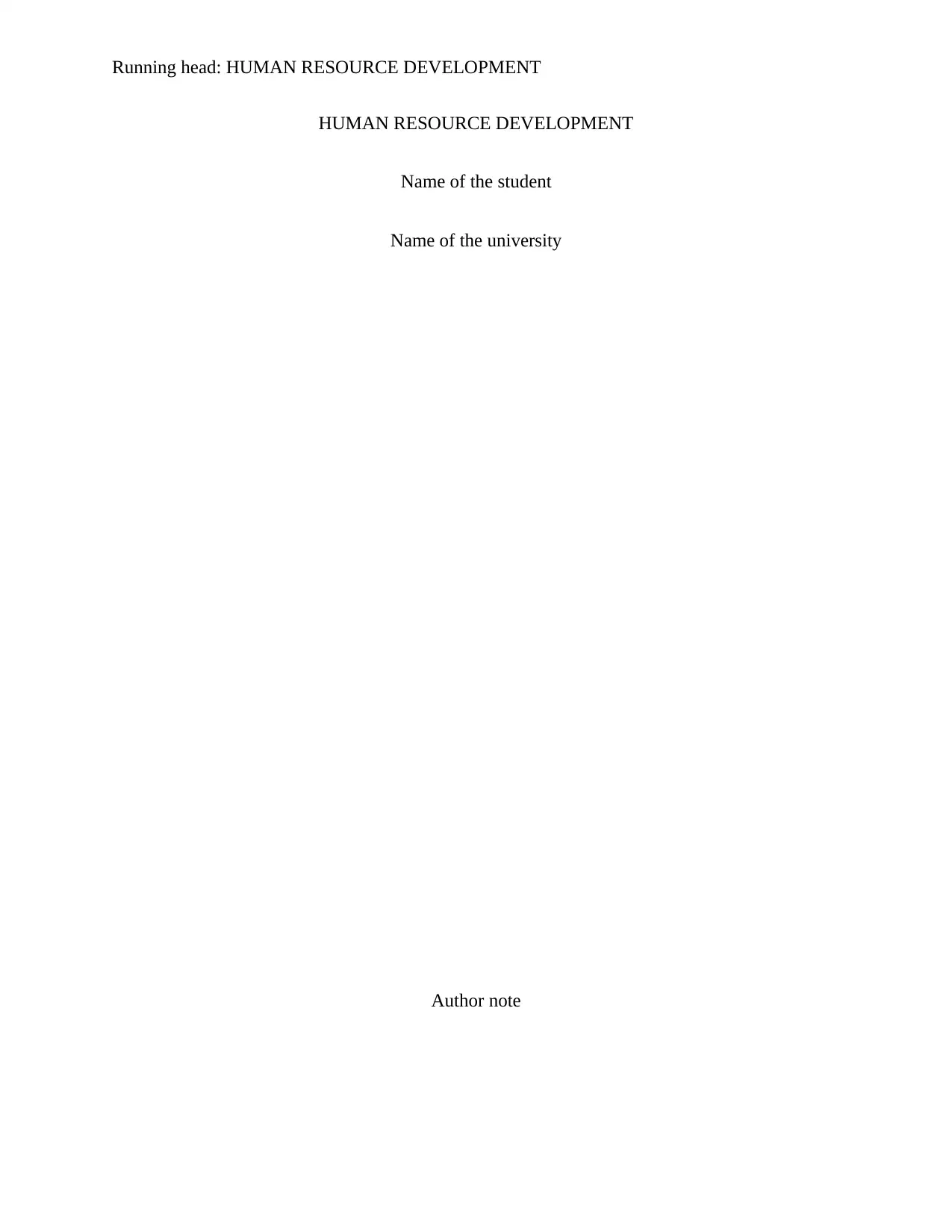
Running head: HUMAN RESOURCE DEVELOPMENT
HUMAN RESOURCE DEVELOPMENT
Name of the student
Name of the university
Author note
HUMAN RESOURCE DEVELOPMENT
Name of the student
Name of the university
Author note
Paraphrase This Document
Need a fresh take? Get an instant paraphrase of this document with our AI Paraphraser
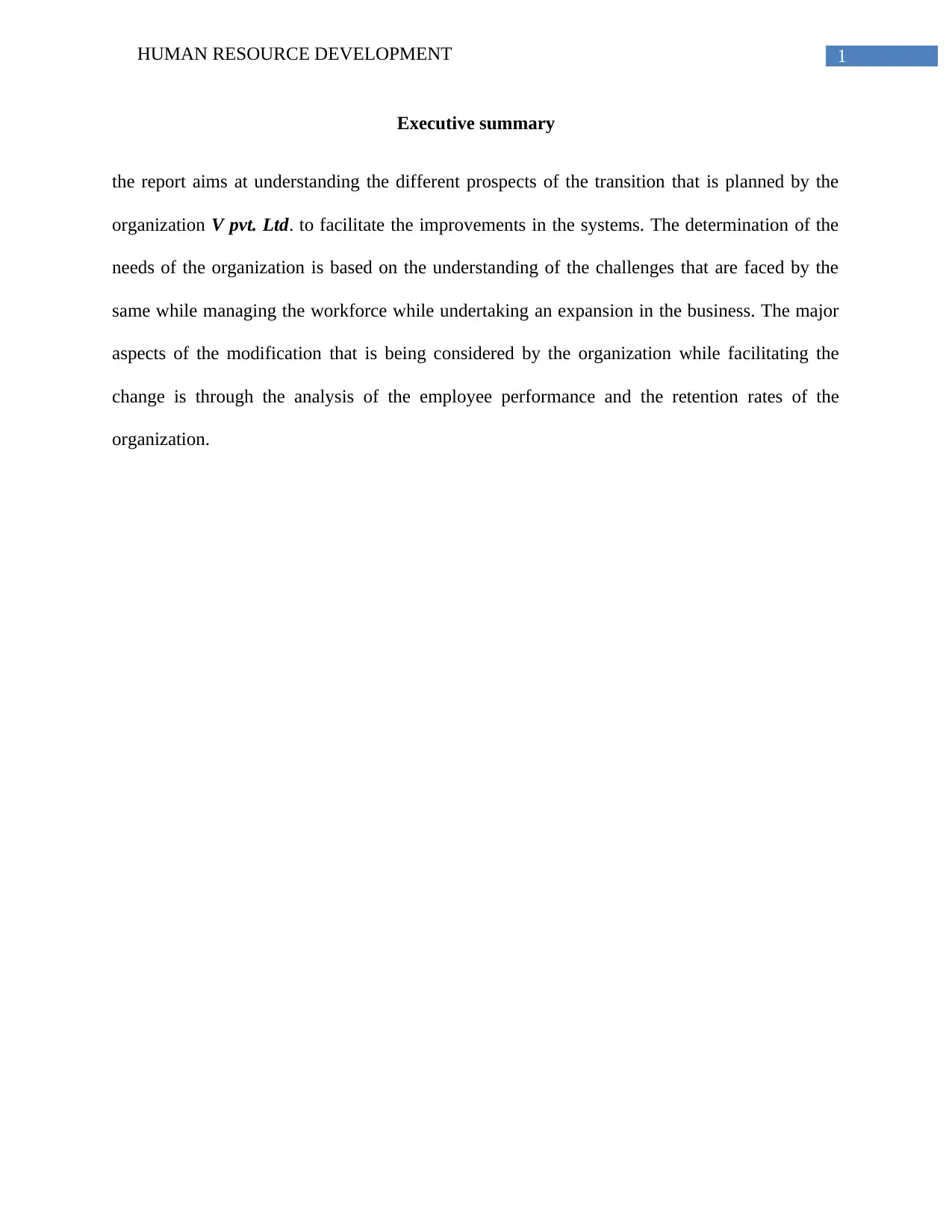
1HUMAN RESOURCE DEVELOPMENT
Executive summary
the report aims at understanding the different prospects of the transition that is planned by the
organization V pvt. Ltd. to facilitate the improvements in the systems. The determination of the
needs of the organization is based on the understanding of the challenges that are faced by the
same while managing the workforce while undertaking an expansion in the business. The major
aspects of the modification that is being considered by the organization while facilitating the
change is through the analysis of the employee performance and the retention rates of the
organization.
Executive summary
the report aims at understanding the different prospects of the transition that is planned by the
organization V pvt. Ltd. to facilitate the improvements in the systems. The determination of the
needs of the organization is based on the understanding of the challenges that are faced by the
same while managing the workforce while undertaking an expansion in the business. The major
aspects of the modification that is being considered by the organization while facilitating the
change is through the analysis of the employee performance and the retention rates of the
organization.
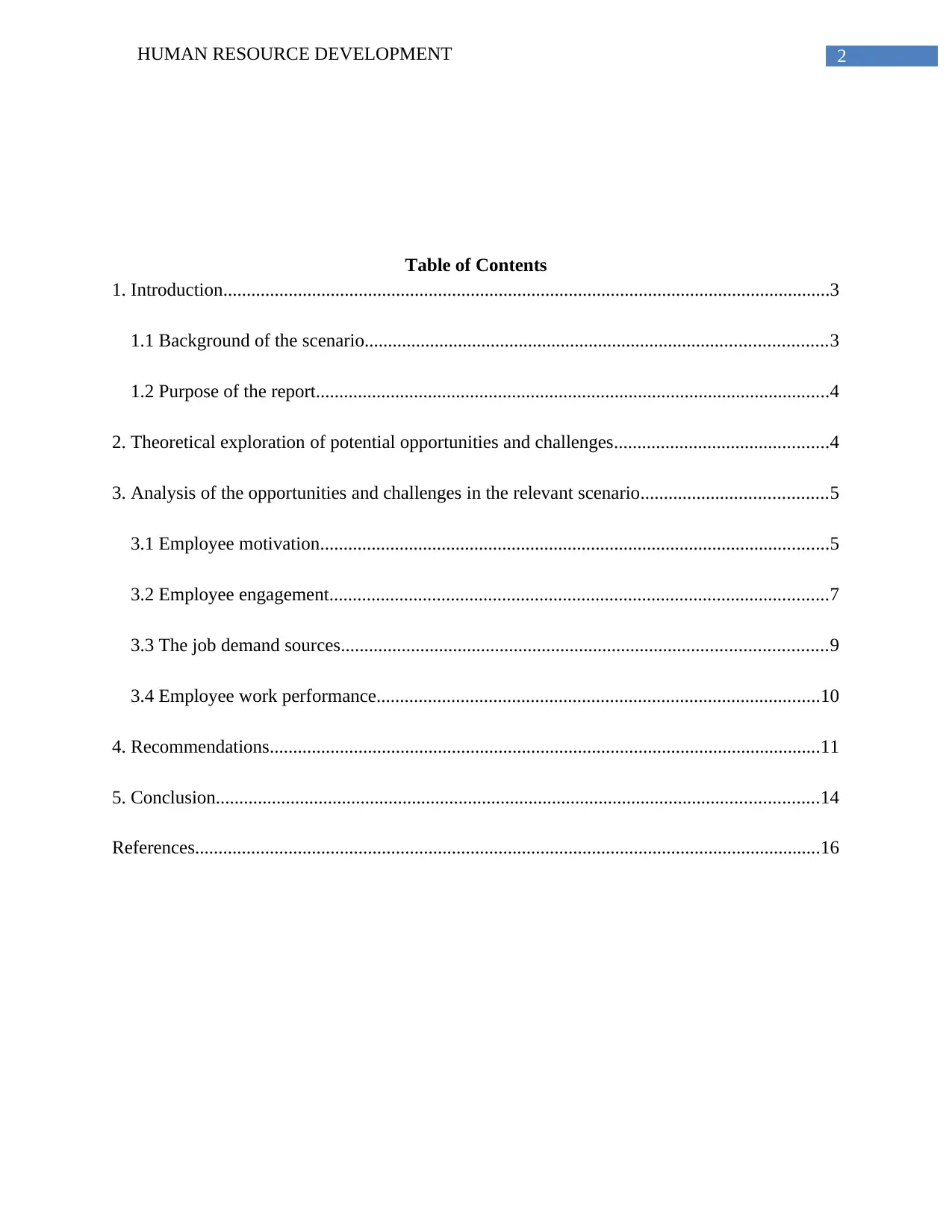
2HUMAN RESOURCE DEVELOPMENT
Table of Contents
1. Introduction..................................................................................................................................3
1.1 Background of the scenario...................................................................................................3
1.2 Purpose of the report..............................................................................................................4
2. Theoretical exploration of potential opportunities and challenges..............................................4
3. Analysis of the opportunities and challenges in the relevant scenario........................................5
3.1 Employee motivation.............................................................................................................5
3.2 Employee engagement...........................................................................................................7
3.3 The job demand sources........................................................................................................9
3.4 Employee work performance...............................................................................................10
4. Recommendations......................................................................................................................11
5. Conclusion.................................................................................................................................14
References......................................................................................................................................16
Table of Contents
1. Introduction..................................................................................................................................3
1.1 Background of the scenario...................................................................................................3
1.2 Purpose of the report..............................................................................................................4
2. Theoretical exploration of potential opportunities and challenges..............................................4
3. Analysis of the opportunities and challenges in the relevant scenario........................................5
3.1 Employee motivation.............................................................................................................5
3.2 Employee engagement...........................................................................................................7
3.3 The job demand sources........................................................................................................9
3.4 Employee work performance...............................................................................................10
4. Recommendations......................................................................................................................11
5. Conclusion.................................................................................................................................14
References......................................................................................................................................16
⊘ This is a preview!⊘
Do you want full access?
Subscribe today to unlock all pages.

Trusted by 1+ million students worldwide
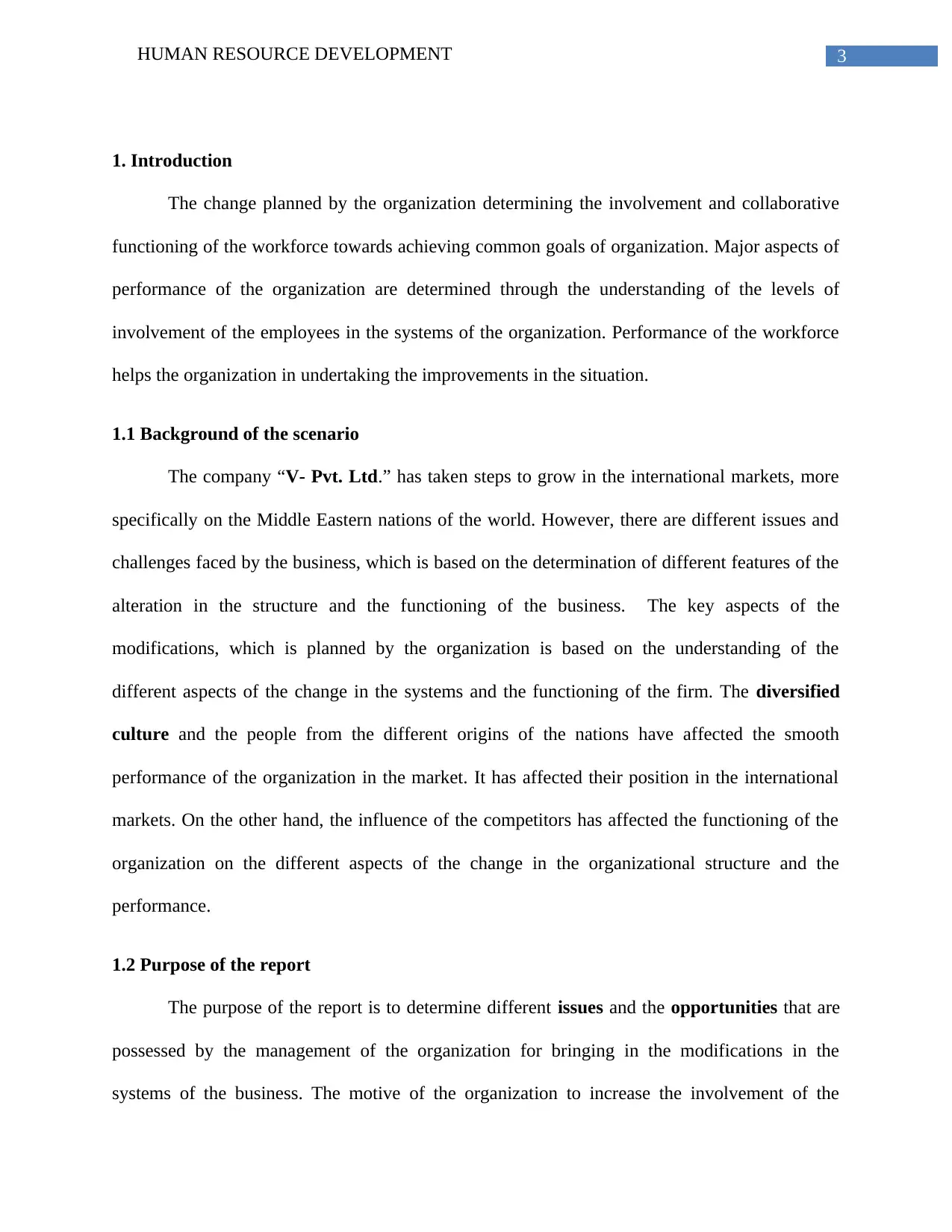
3HUMAN RESOURCE DEVELOPMENT
1. Introduction
The change planned by the organization determining the involvement and collaborative
functioning of the workforce towards achieving common goals of organization. Major aspects of
performance of the organization are determined through the understanding of the levels of
involvement of the employees in the systems of the organization. Performance of the workforce
helps the organization in undertaking the improvements in the situation.
1.1 Background of the scenario
The company “V- Pvt. Ltd.” has taken steps to grow in the international markets, more
specifically on the Middle Eastern nations of the world. However, there are different issues and
challenges faced by the business, which is based on the determination of different features of the
alteration in the structure and the functioning of the business. The key aspects of the
modifications, which is planned by the organization is based on the understanding of the
different aspects of the change in the systems and the functioning of the firm. The diversified
culture and the people from the different origins of the nations have affected the smooth
performance of the organization in the market. It has affected their position in the international
markets. On the other hand, the influence of the competitors has affected the functioning of the
organization on the different aspects of the change in the organizational structure and the
performance.
1.2 Purpose of the report
The purpose of the report is to determine different issues and the opportunities that are
possessed by the management of the organization for bringing in the modifications in the
systems of the business. The motive of the organization to increase the involvement of the
1. Introduction
The change planned by the organization determining the involvement and collaborative
functioning of the workforce towards achieving common goals of organization. Major aspects of
performance of the organization are determined through the understanding of the levels of
involvement of the employees in the systems of the organization. Performance of the workforce
helps the organization in undertaking the improvements in the situation.
1.1 Background of the scenario
The company “V- Pvt. Ltd.” has taken steps to grow in the international markets, more
specifically on the Middle Eastern nations of the world. However, there are different issues and
challenges faced by the business, which is based on the determination of different features of the
alteration in the structure and the functioning of the business. The key aspects of the
modifications, which is planned by the organization is based on the understanding of the
different aspects of the change in the systems and the functioning of the firm. The diversified
culture and the people from the different origins of the nations have affected the smooth
performance of the organization in the market. It has affected their position in the international
markets. On the other hand, the influence of the competitors has affected the functioning of the
organization on the different aspects of the change in the organizational structure and the
performance.
1.2 Purpose of the report
The purpose of the report is to determine different issues and the opportunities that are
possessed by the management of the organization for bringing in the modifications in the
systems of the business. The motive of the organization to increase the involvement of the
Paraphrase This Document
Need a fresh take? Get an instant paraphrase of this document with our AI Paraphraser
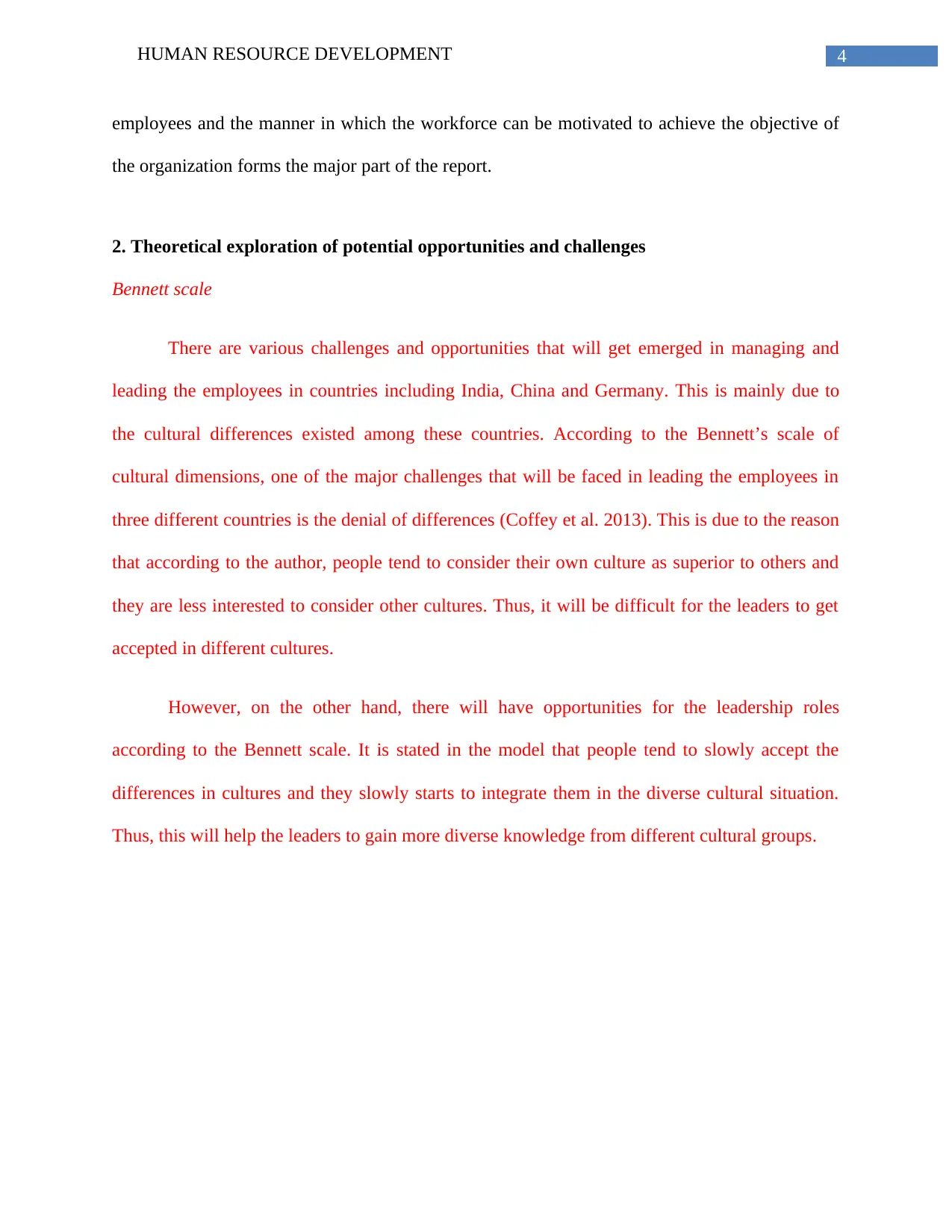
4HUMAN RESOURCE DEVELOPMENT
employees and the manner in which the workforce can be motivated to achieve the objective of
the organization forms the major part of the report.
2. Theoretical exploration of potential opportunities and challenges
Bennett scale
There are various challenges and opportunities that will get emerged in managing and
leading the employees in countries including India, China and Germany. This is mainly due to
the cultural differences existed among these countries. According to the Bennett’s scale of
cultural dimensions, one of the major challenges that will be faced in leading the employees in
three different countries is the denial of differences (Coffey et al. 2013). This is due to the reason
that according to the author, people tend to consider their own culture as superior to others and
they are less interested to consider other cultures. Thus, it will be difficult for the leaders to get
accepted in different cultures.
However, on the other hand, there will have opportunities for the leadership roles
according to the Bennett scale. It is stated in the model that people tend to slowly accept the
differences in cultures and they slowly starts to integrate them in the diverse cultural situation.
Thus, this will help the leaders to gain more diverse knowledge from different cultural groups.
employees and the manner in which the workforce can be motivated to achieve the objective of
the organization forms the major part of the report.
2. Theoretical exploration of potential opportunities and challenges
Bennett scale
There are various challenges and opportunities that will get emerged in managing and
leading the employees in countries including India, China and Germany. This is mainly due to
the cultural differences existed among these countries. According to the Bennett’s scale of
cultural dimensions, one of the major challenges that will be faced in leading the employees in
three different countries is the denial of differences (Coffey et al. 2013). This is due to the reason
that according to the author, people tend to consider their own culture as superior to others and
they are less interested to consider other cultures. Thus, it will be difficult for the leaders to get
accepted in different cultures.
However, on the other hand, there will have opportunities for the leadership roles
according to the Bennett scale. It is stated in the model that people tend to slowly accept the
differences in cultures and they slowly starts to integrate them in the diverse cultural situation.
Thus, this will help the leaders to gain more diverse knowledge from different cultural groups.
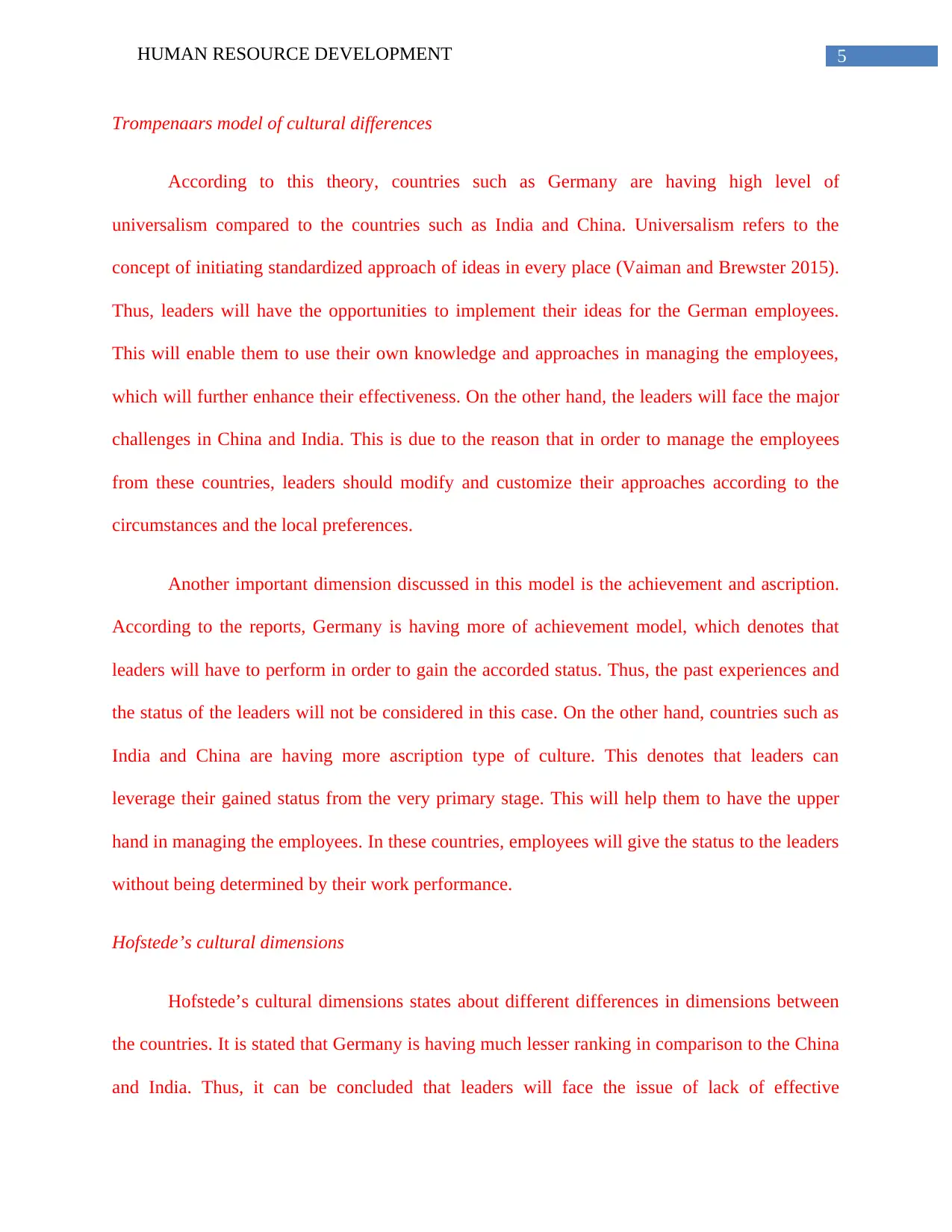
5HUMAN RESOURCE DEVELOPMENT
Trompenaars model of cultural differences
According to this theory, countries such as Germany are having high level of
universalism compared to the countries such as India and China. Universalism refers to the
concept of initiating standardized approach of ideas in every place (Vaiman and Brewster 2015).
Thus, leaders will have the opportunities to implement their ideas for the German employees.
This will enable them to use their own knowledge and approaches in managing the employees,
which will further enhance their effectiveness. On the other hand, the leaders will face the major
challenges in China and India. This is due to the reason that in order to manage the employees
from these countries, leaders should modify and customize their approaches according to the
circumstances and the local preferences.
Another important dimension discussed in this model is the achievement and ascription.
According to the reports, Germany is having more of achievement model, which denotes that
leaders will have to perform in order to gain the accorded status. Thus, the past experiences and
the status of the leaders will not be considered in this case. On the other hand, countries such as
India and China are having more ascription type of culture. This denotes that leaders can
leverage their gained status from the very primary stage. This will help them to have the upper
hand in managing the employees. In these countries, employees will give the status to the leaders
without being determined by their work performance.
Hofstede’s cultural dimensions
Hofstede’s cultural dimensions states about different differences in dimensions between
the countries. It is stated that Germany is having much lesser ranking in comparison to the China
and India. Thus, it can be concluded that leaders will face the issue of lack of effective
Trompenaars model of cultural differences
According to this theory, countries such as Germany are having high level of
universalism compared to the countries such as India and China. Universalism refers to the
concept of initiating standardized approach of ideas in every place (Vaiman and Brewster 2015).
Thus, leaders will have the opportunities to implement their ideas for the German employees.
This will enable them to use their own knowledge and approaches in managing the employees,
which will further enhance their effectiveness. On the other hand, the leaders will face the major
challenges in China and India. This is due to the reason that in order to manage the employees
from these countries, leaders should modify and customize their approaches according to the
circumstances and the local preferences.
Another important dimension discussed in this model is the achievement and ascription.
According to the reports, Germany is having more of achievement model, which denotes that
leaders will have to perform in order to gain the accorded status. Thus, the past experiences and
the status of the leaders will not be considered in this case. On the other hand, countries such as
India and China are having more ascription type of culture. This denotes that leaders can
leverage their gained status from the very primary stage. This will help them to have the upper
hand in managing the employees. In these countries, employees will give the status to the leaders
without being determined by their work performance.
Hofstede’s cultural dimensions
Hofstede’s cultural dimensions states about different differences in dimensions between
the countries. It is stated that Germany is having much lesser ranking in comparison to the China
and India. Thus, it can be concluded that leaders will face the issue of lack of effective
⊘ This is a preview!⊘
Do you want full access?
Subscribe today to unlock all pages.

Trusted by 1+ million students worldwide
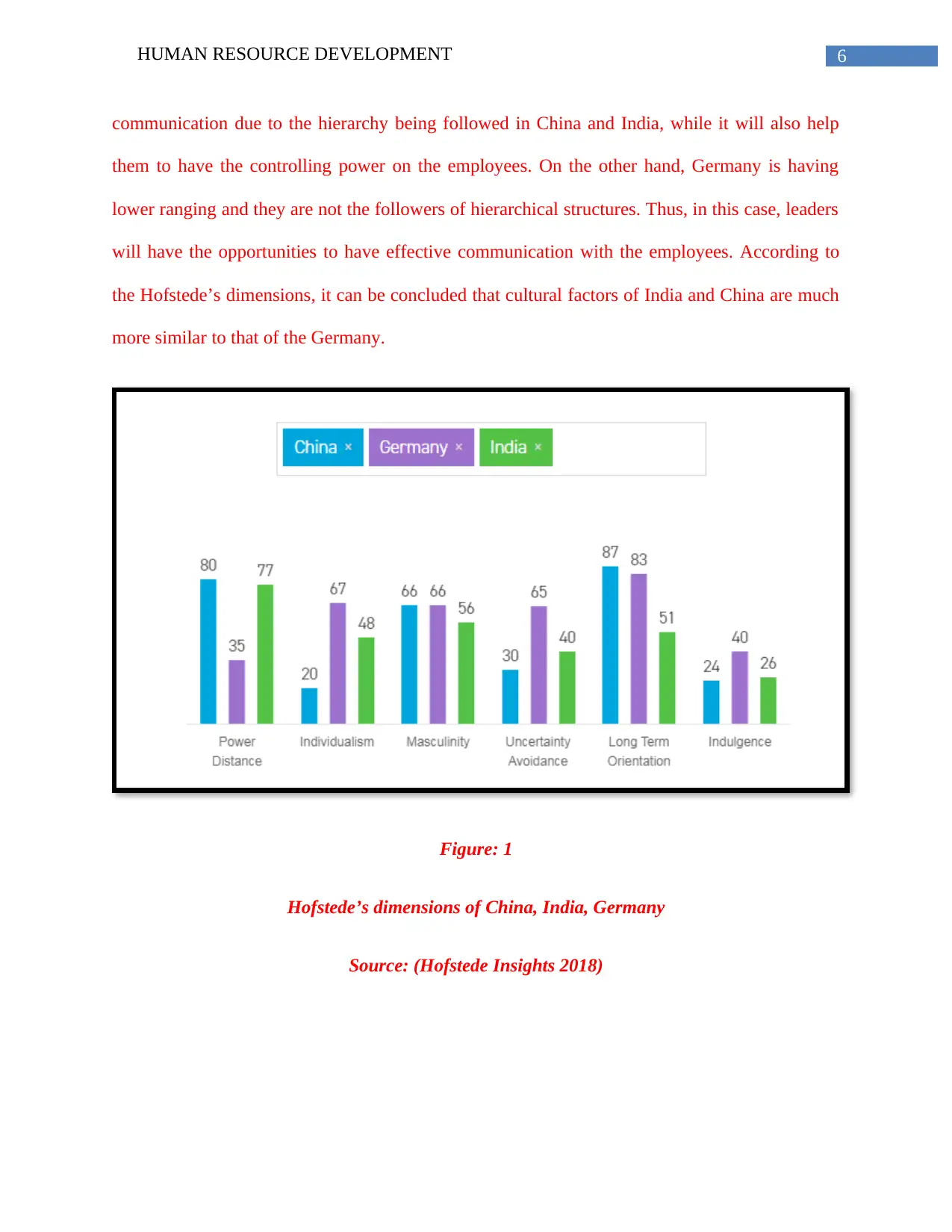
6HUMAN RESOURCE DEVELOPMENT
communication due to the hierarchy being followed in China and India, while it will also help
them to have the controlling power on the employees. On the other hand, Germany is having
lower ranging and they are not the followers of hierarchical structures. Thus, in this case, leaders
will have the opportunities to have effective communication with the employees. According to
the Hofstede’s dimensions, it can be concluded that cultural factors of India and China are much
more similar to that of the Germany.
Figure: 1
Hofstede’s dimensions of China, India, Germany
Source: (Hofstede Insights 2018)
communication due to the hierarchy being followed in China and India, while it will also help
them to have the controlling power on the employees. On the other hand, Germany is having
lower ranging and they are not the followers of hierarchical structures. Thus, in this case, leaders
will have the opportunities to have effective communication with the employees. According to
the Hofstede’s dimensions, it can be concluded that cultural factors of India and China are much
more similar to that of the Germany.
Figure: 1
Hofstede’s dimensions of China, India, Germany
Source: (Hofstede Insights 2018)
Paraphrase This Document
Need a fresh take? Get an instant paraphrase of this document with our AI Paraphraser
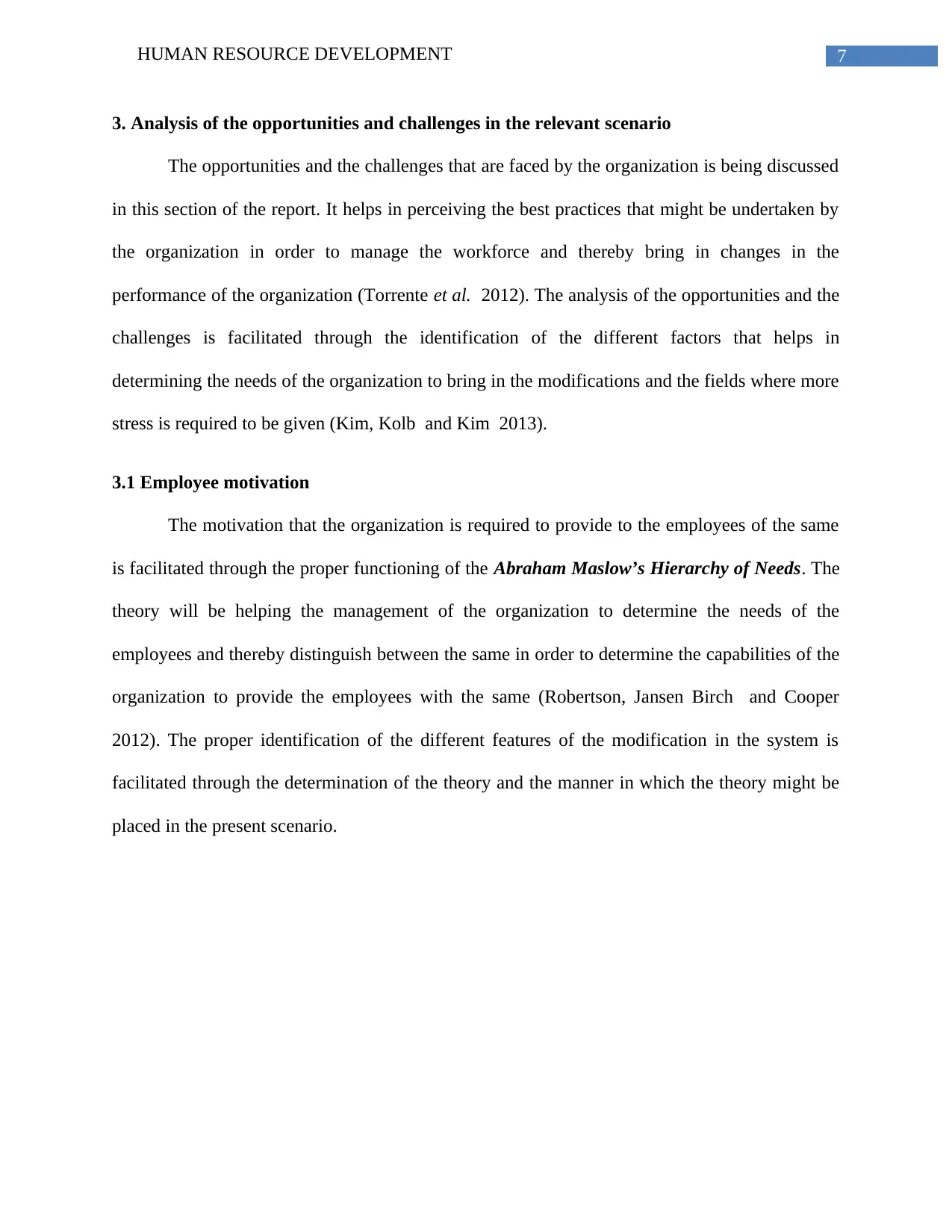
7HUMAN RESOURCE DEVELOPMENT
3. Analysis of the opportunities and challenges in the relevant scenario
The opportunities and the challenges that are faced by the organization is being discussed
in this section of the report. It helps in perceiving the best practices that might be undertaken by
the organization in order to manage the workforce and thereby bring in changes in the
performance of the organization (Torrente et al. 2012). The analysis of the opportunities and the
challenges is facilitated through the identification of the different factors that helps in
determining the needs of the organization to bring in the modifications and the fields where more
stress is required to be given (Kim, Kolb and Kim 2013).
3.1 Employee motivation
The motivation that the organization is required to provide to the employees of the same
is facilitated through the proper functioning of the Abraham Maslow’s Hierarchy of Needs. The
theory will be helping the management of the organization to determine the needs of the
employees and thereby distinguish between the same in order to determine the capabilities of the
organization to provide the employees with the same (Robertson, Jansen Birch and Cooper
2012). The proper identification of the different features of the modification in the system is
facilitated through the determination of the theory and the manner in which the theory might be
placed in the present scenario.
3. Analysis of the opportunities and challenges in the relevant scenario
The opportunities and the challenges that are faced by the organization is being discussed
in this section of the report. It helps in perceiving the best practices that might be undertaken by
the organization in order to manage the workforce and thereby bring in changes in the
performance of the organization (Torrente et al. 2012). The analysis of the opportunities and the
challenges is facilitated through the identification of the different factors that helps in
determining the needs of the organization to bring in the modifications and the fields where more
stress is required to be given (Kim, Kolb and Kim 2013).
3.1 Employee motivation
The motivation that the organization is required to provide to the employees of the same
is facilitated through the proper functioning of the Abraham Maslow’s Hierarchy of Needs. The
theory will be helping the management of the organization to determine the needs of the
employees and thereby distinguish between the same in order to determine the capabilities of the
organization to provide the employees with the same (Robertson, Jansen Birch and Cooper
2012). The proper identification of the different features of the modification in the system is
facilitated through the determination of the theory and the manner in which the theory might be
placed in the present scenario.
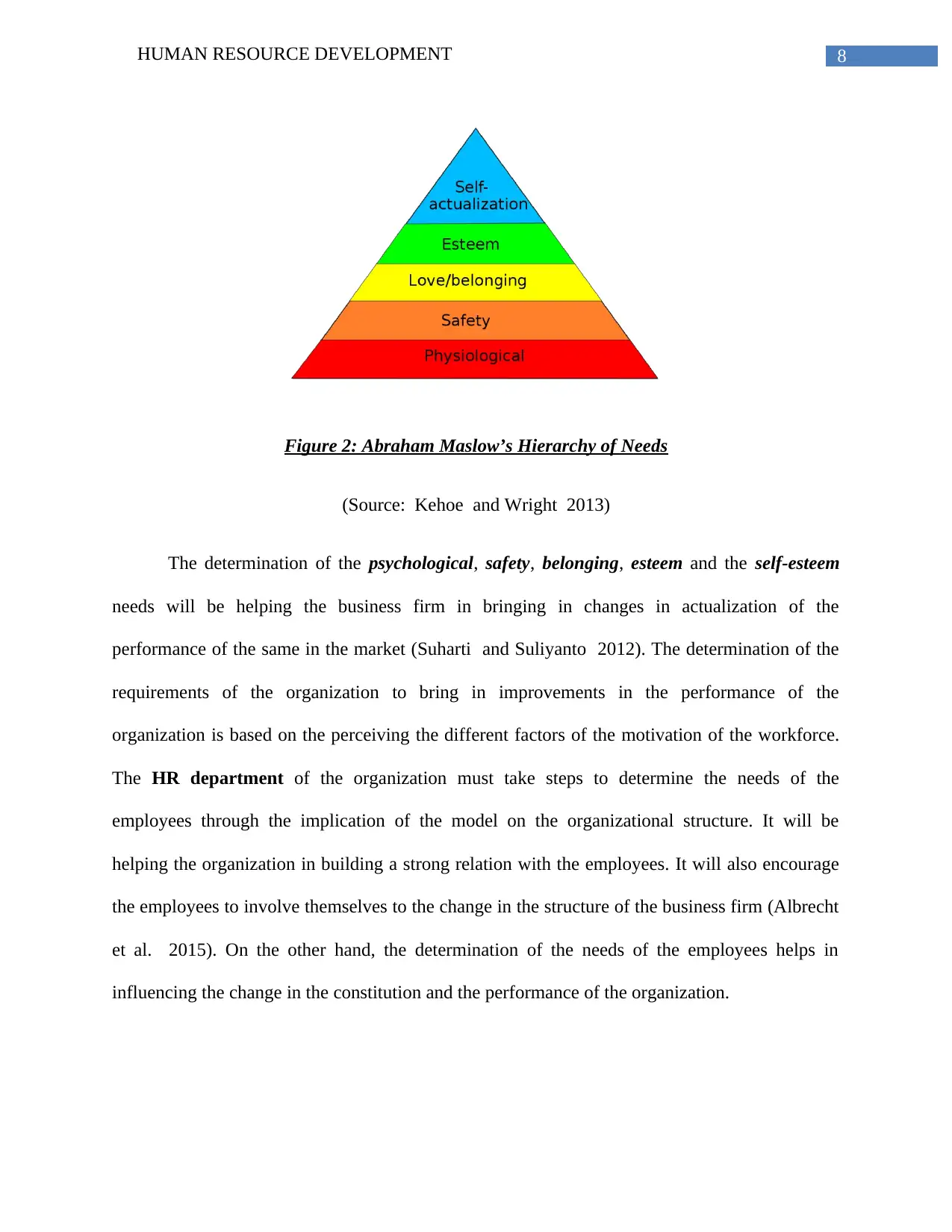
8HUMAN RESOURCE DEVELOPMENT
Figure 2: Abraham Maslow’s Hierarchy of Needs
(Source: Kehoe and Wright 2013)
The determination of the psychological, safety, belonging, esteem and the self-esteem
needs will be helping the business firm in bringing in changes in actualization of the
performance of the same in the market (Suharti and Suliyanto 2012). The determination of the
requirements of the organization to bring in improvements in the performance of the
organization is based on the perceiving the different factors of the motivation of the workforce.
The HR department of the organization must take steps to determine the needs of the
employees through the implication of the model on the organizational structure. It will be
helping the organization in building a strong relation with the employees. It will also encourage
the employees to involve themselves to the change in the structure of the business firm (Albrecht
et al. 2015). On the other hand, the determination of the needs of the employees helps in
influencing the change in the constitution and the performance of the organization.
Figure 2: Abraham Maslow’s Hierarchy of Needs
(Source: Kehoe and Wright 2013)
The determination of the psychological, safety, belonging, esteem and the self-esteem
needs will be helping the business firm in bringing in changes in actualization of the
performance of the same in the market (Suharti and Suliyanto 2012). The determination of the
requirements of the organization to bring in improvements in the performance of the
organization is based on the perceiving the different factors of the motivation of the workforce.
The HR department of the organization must take steps to determine the needs of the
employees through the implication of the model on the organizational structure. It will be
helping the organization in building a strong relation with the employees. It will also encourage
the employees to involve themselves to the change in the structure of the business firm (Albrecht
et al. 2015). On the other hand, the determination of the needs of the employees helps in
influencing the change in the constitution and the performance of the organization.
⊘ This is a preview!⊘
Do you want full access?
Subscribe today to unlock all pages.

Trusted by 1+ million students worldwide
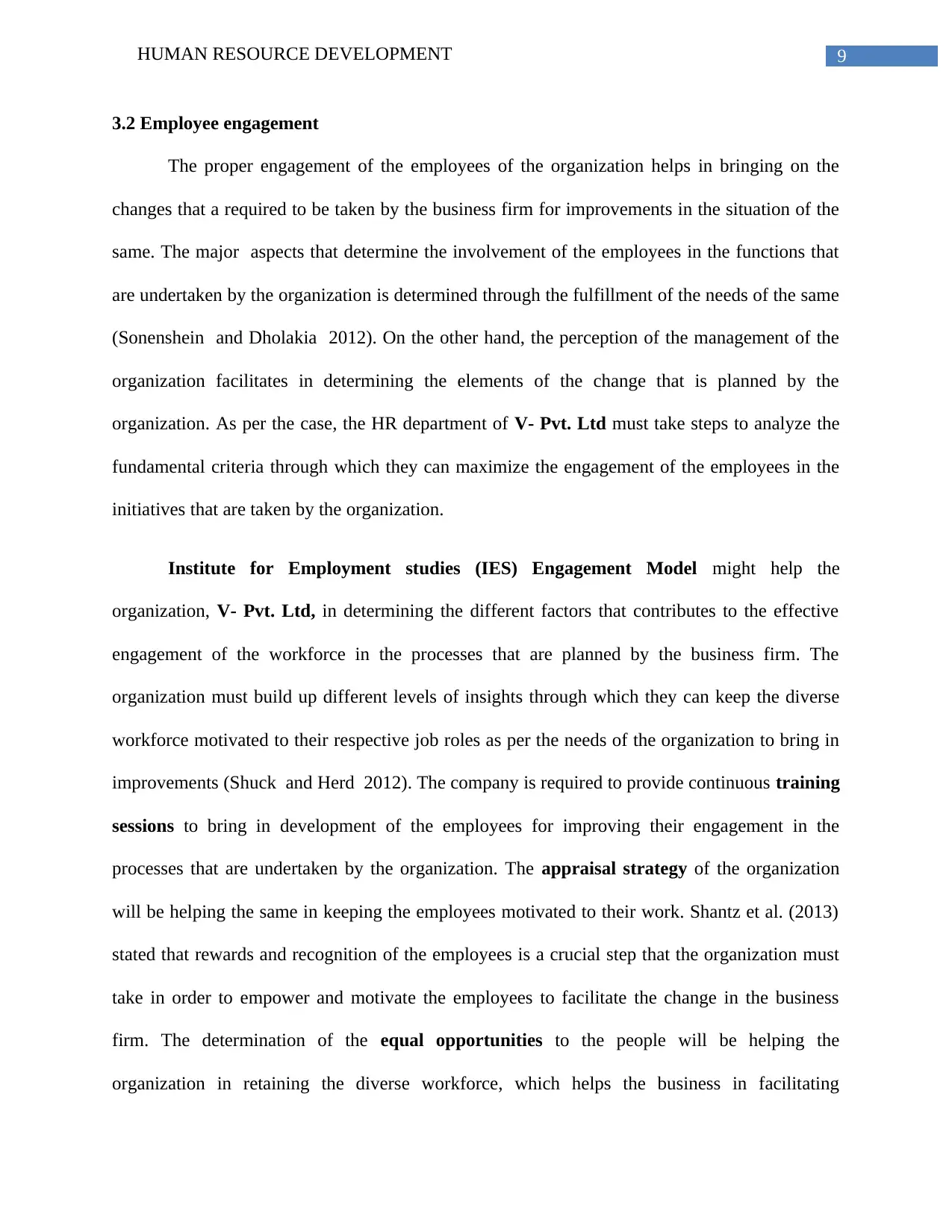
9HUMAN RESOURCE DEVELOPMENT
3.2 Employee engagement
The proper engagement of the employees of the organization helps in bringing on the
changes that a required to be taken by the business firm for improvements in the situation of the
same. The major aspects that determine the involvement of the employees in the functions that
are undertaken by the organization is determined through the fulfillment of the needs of the same
(Sonenshein and Dholakia 2012). On the other hand, the perception of the management of the
organization facilitates in determining the elements of the change that is planned by the
organization. As per the case, the HR department of V- Pvt. Ltd must take steps to analyze the
fundamental criteria through which they can maximize the engagement of the employees in the
initiatives that are taken by the organization.
Institute for Employment studies (IES) Engagement Model might help the
organization, V- Pvt. Ltd, in determining the different factors that contributes to the effective
engagement of the workforce in the processes that are planned by the business firm. The
organization must build up different levels of insights through which they can keep the diverse
workforce motivated to their respective job roles as per the needs of the organization to bring in
improvements (Shuck and Herd 2012). The company is required to provide continuous training
sessions to bring in development of the employees for improving their engagement in the
processes that are undertaken by the organization. The appraisal strategy of the organization
will be helping the same in keeping the employees motivated to their work. Shantz et al. (2013)
stated that rewards and recognition of the employees is a crucial step that the organization must
take in order to empower and motivate the employees to facilitate the change in the business
firm. The determination of the equal opportunities to the people will be helping the
organization in retaining the diverse workforce, which helps the business in facilitating
3.2 Employee engagement
The proper engagement of the employees of the organization helps in bringing on the
changes that a required to be taken by the business firm for improvements in the situation of the
same. The major aspects that determine the involvement of the employees in the functions that
are undertaken by the organization is determined through the fulfillment of the needs of the same
(Sonenshein and Dholakia 2012). On the other hand, the perception of the management of the
organization facilitates in determining the elements of the change that is planned by the
organization. As per the case, the HR department of V- Pvt. Ltd must take steps to analyze the
fundamental criteria through which they can maximize the engagement of the employees in the
initiatives that are taken by the organization.
Institute for Employment studies (IES) Engagement Model might help the
organization, V- Pvt. Ltd, in determining the different factors that contributes to the effective
engagement of the workforce in the processes that are planned by the business firm. The
organization must build up different levels of insights through which they can keep the diverse
workforce motivated to their respective job roles as per the needs of the organization to bring in
improvements (Shuck and Herd 2012). The company is required to provide continuous training
sessions to bring in development of the employees for improving their engagement in the
processes that are undertaken by the organization. The appraisal strategy of the organization
will be helping the same in keeping the employees motivated to their work. Shantz et al. (2013)
stated that rewards and recognition of the employees is a crucial step that the organization must
take in order to empower and motivate the employees to facilitate the change in the business
firm. The determination of the equal opportunities to the people will be helping the
organization in retaining the diverse workforce, which helps the business in facilitating
Paraphrase This Document
Need a fresh take? Get an instant paraphrase of this document with our AI Paraphraser
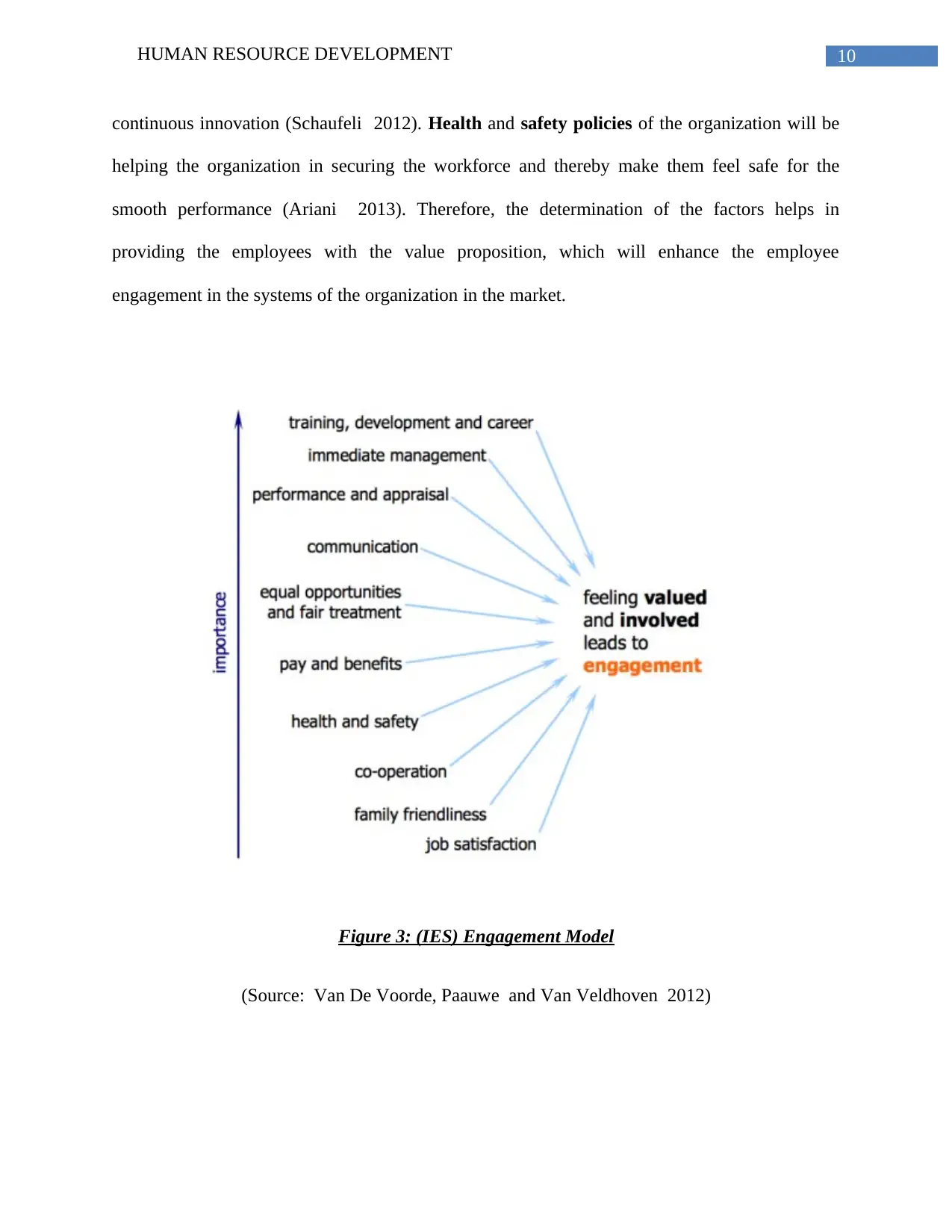
10HUMAN RESOURCE DEVELOPMENT
continuous innovation (Schaufeli 2012). Health and safety policies of the organization will be
helping the organization in securing the workforce and thereby make them feel safe for the
smooth performance (Ariani 2013). Therefore, the determination of the factors helps in
providing the employees with the value proposition, which will enhance the employee
engagement in the systems of the organization in the market.
Figure 3: (IES) Engagement Model
(Source: Van De Voorde, Paauwe and Van Veldhoven 2012)
continuous innovation (Schaufeli 2012). Health and safety policies of the organization will be
helping the organization in securing the workforce and thereby make them feel safe for the
smooth performance (Ariani 2013). Therefore, the determination of the factors helps in
providing the employees with the value proposition, which will enhance the employee
engagement in the systems of the organization in the market.
Figure 3: (IES) Engagement Model
(Source: Van De Voorde, Paauwe and Van Veldhoven 2012)

11HUMAN RESOURCE DEVELOPMENT
3.3 The job demand sources
The determination of the commitment of the employees determines the different aspects
of the transition that is planned by the business. On the other hand, the balance in the job
demands and job resources will be helping the organization in understanding the involvement of
the employees to the function that is planned by the firm (Menguc et al. 2013). On the other
hand, the determination of the needs of the organization is based on the functioning of the
resource capability of the business to suffice to the demands of the employees. It helps in
determining the change in the performance of the organization.
The determination of the (JD-R) model helps in determining the activity of the
employees. The Key aspect of the change that is being planned by the organization is based on
the committed functioning of the workforce (Bedarkar and Pandita 2014). The job satisfaction
of the employees plays a major role in perceiving the different levels of the change in the
structure and the functioning of the business, which will be helping the organization in making
continuous improvements in the systems, and the functioning of the organization in the market.
Dalal et al. (2012) stated that the involvement of the employees in the different levels of the
transition helps the firm in bringing forth the modifications in the systems (Hoon Song et al.
2012). The motivation of the workforce helps in determining the determination of the
modification objective of the business. The enormous pressure that is felt by the employees due
to the subtle changes in the organization determines the processing of the same. However, the
company must take steps in order to defend the interests of the employees in order to support the
job satisfaction of the employees.
3.3 The job demand sources
The determination of the commitment of the employees determines the different aspects
of the transition that is planned by the business. On the other hand, the balance in the job
demands and job resources will be helping the organization in understanding the involvement of
the employees to the function that is planned by the firm (Menguc et al. 2013). On the other
hand, the determination of the needs of the organization is based on the functioning of the
resource capability of the business to suffice to the demands of the employees. It helps in
determining the change in the performance of the organization.
The determination of the (JD-R) model helps in determining the activity of the
employees. The Key aspect of the change that is being planned by the organization is based on
the committed functioning of the workforce (Bedarkar and Pandita 2014). The job satisfaction
of the employees plays a major role in perceiving the different levels of the change in the
structure and the functioning of the business, which will be helping the organization in making
continuous improvements in the systems, and the functioning of the organization in the market.
Dalal et al. (2012) stated that the involvement of the employees in the different levels of the
transition helps the firm in bringing forth the modifications in the systems (Hoon Song et al.
2012). The motivation of the workforce helps in determining the determination of the
modification objective of the business. The enormous pressure that is felt by the employees due
to the subtle changes in the organization determines the processing of the same. However, the
company must take steps in order to defend the interests of the employees in order to support the
job satisfaction of the employees.
⊘ This is a preview!⊘
Do you want full access?
Subscribe today to unlock all pages.

Trusted by 1+ million students worldwide
1 out of 22
Related Documents
Your All-in-One AI-Powered Toolkit for Academic Success.
+13062052269
info@desklib.com
Available 24*7 on WhatsApp / Email
![[object Object]](/_next/static/media/star-bottom.7253800d.svg)
Unlock your academic potential
Copyright © 2020–2025 A2Z Services. All Rights Reserved. Developed and managed by ZUCOL.





